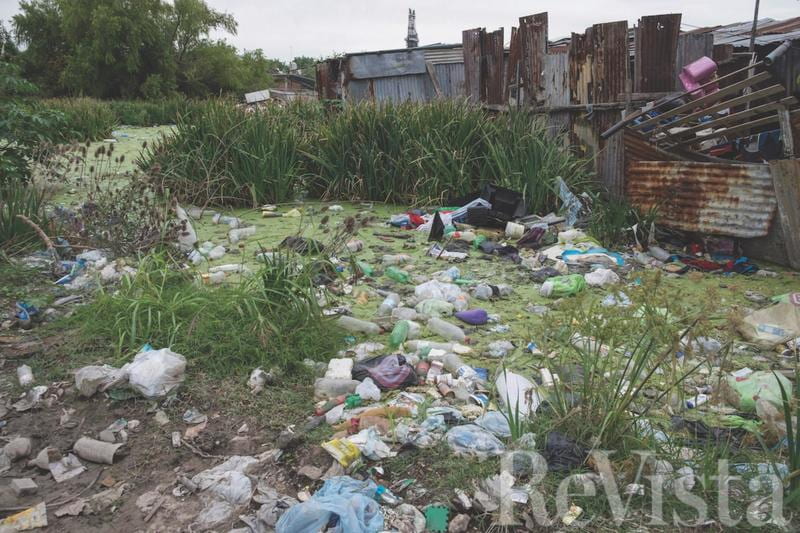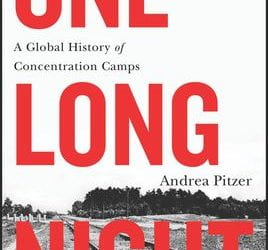Beyond Climate Change:
The Latin American Sewage Crisis and Environmental Justice
Carmen offered to show us around the neighborhood. We turned onto unpaved streets that housed surprisingly dissimilar buildings. Homes made of brick and mortar with finished lawns and paved entryways sat next to corrugated tin houses with plastic bags for windows. Yet they all shared something in common: they were surrounded by lagoons full of garbage and human waste. In Villa Inflamable, a shantytown in Buenos Aires, Argentina, enterprising residents had improvised a solution to the lack of sewers in their neighborhood by running hoses underground to take wastewater from their bathrooms to open lagoons a few meters away. The result was green lagoons composed of raw sewage and strewn with plastic bottles, car parts and bags full of kitchen scraps. Carmen told us that last year her two children had been diagnosed with lead poisoning. Her house sat adjacent to the Matanza-Riachuelo River, a waterway that traverses the capital city and has made the top ten list of the most contaminated places in the world.
Carmen has never heard of climate change. The environmental problems she faces are not directly linked to greenhouse emissions, yet they are shared by millions. According to the World Health Organization, one out of four people dies every year from living or working near toxic pollution. Ninety-two percent of these deaths occur in middle or low-income countries, where the majority of the global population lives. A 2017 Lancet Commission report estimated that pollution causes losses of US$4.6 trillion per year—6.2 percent of global economic output. While some forms of pollution, such as air pollution, are closely aligned with determinants of greenhouse emissions and share common solutions, other forms, such as water pollution, are not.
The largest contributor of water pollution is untreated wastewater, a fast growing, global problem that has been neglected by the international community because its determinants are largely local and not linked to the drivers of climate change. Yet environmental degradation from wastewater pollution is global in reach, impacting most of the world’s population and ecosystems. Less than 20 percent of global wastewater—including residential, industrial and agricultural water—receives any form of treatment; this figure is only eight percent in low-income countries. In Latin America, approximately 22 percent of wastewater receives treatment, but some studies show that the total percentage of wastewater being managed sustainably may be as low as 11 percent.
The spread of the global climate change agenda has coincided with the upsurge in the urban sewage crises in Latin America. Unplanned urbanization has skyrocketed in the region; Eight out of every 10 people in Latin America now live in cities, a migration accompanied by unregulated industrialization. Environmental organization leaders I interviewed in Colombia and Argentina stressed the difficult access to international financing for sewage contamination because of international environmental foundations’ singular focus on transborder climate change initiatives. Indeed, wastewater management has little appeal to international foundations, policymakers and even academics who work on environmental issues.
But sewage pollution, even without climate change, is a pressing environmental policy problem. The United Nations reports that severe pathogen pollution (from fecal contamination) affects one third of all rivers globally and presents health risks from drinking contaminated water, bathing, laundering and other household activities. Severe organic pollution from herbicides, pesticides and industrial compounds also pour into many rivers. In Latin America, about one out of every three rivers is polluted by wastewater and solid waste (the region produces 160 million tons of waste annually, or 12 percent of the world’s waste).
Sewage as an environmental problem has direct impacts on ecosystems. The Millennium Ecosystem Assessment reports that 60 percent of global ecosystem services, on which many social and economic activities depend, are being degraded. Agricultural practices, population growth and industrialization are creating excessive nitrogen and phosphorus dumping into waterways. The result is toxic algal blooms, or eutrophication, which is the dramatic growth of plant biomass, an alarming development visible in Villa Inflamable’s green lagoons.
There ia an inextricable relationship between ecosystem degradation and human health. Unmanaged wastewater is a vector for disease, including typhoid, paratyphoid, dysentery, gastroenteritis and cholera. More than half of the hospitalized global population suffers from water-related diseases, and diarrheal diseases make up more than four percent of the global disease burden. The World Health Organization estimates that approximately 58 percent of all cases of diarrhea in low and middle-income countries are attributable to the environment, and they account for 20 percent of global deaths for children under the age of five.
These figures do not include, however, exposure to toxic contamination that many low-income urban communities face from manufacturing firms’ release of heavy metals, chemicals and other nonbiodegradable pollutants into waterways. Villa Inflamable is one extreme example—it surrounds a Shell petrochemical processing plant that transmits soil, air and water toxins. It is not uncommon for manufacturing firms to be located near residential communities in Latin American cities. Residents and activists I interviewed in Buenos Aires and Bogota recounted cases marked by various health problems, such as gastrointestinal illness, lead poisoning, skin lesions and cancers. As health crises mount, many government officials suppress information about the link between industrial pollution and human health, hoping to deflect responsibility and avoid blame.
Climate change will exacerbate environmental degradation and toxic exposure from the wastewater sector, but the factors that contribute to wastewater contamination are not a result of climate change. Non-climate change factors such as aging infrastructure, industrialization and population growth will have similar levels of negative environmental impact in the short term even outside of climate change scenarios. Better understanding the unequal distributive impacts of environmental harms associated with wastewater pollution will surely underscore political, regulatory and social conflicts related to rapid industrialization and urbanization in Latin America. As Victor Hugo noted in Les Miserables (1862), “A sewer is a cynic. It tells everything.”
We need to do a better job of distinguishing between drivers of climate change and other environmental problems that may have distinct causes and consequences. Climate change is often discussed with respect to its distributional over-time tradeoffs—the need for current generations to reduce greenhouse emissions for the good of future generations. Yet pollution abatement presents different distributional tradeoffs. Environmental degradation associated with wastewater, solid waste and toxic dumping disproportionately affects low-income residents who are most likely to live near pollution and most directly suffer its health and economic impacts. Those interested in social justice issues would do well to focus on the global wastewater crisis. More attention is urgently needed to attend to growing pollution in developing countries, which currently account for a large, and growing, percentage of global human deaths and the alarming rate of debilitating ecosystem health. Climate change mitigation is critical, but we do not need to wait decades to experience the worst of the environmental problems that are headed our way. For the majority of low-income residents like Carmen in Latin America and beyond, that future is already here.
Fall 2018, Volume XVIII, Number 1
Veronica Herrera is Assistant Professor of Political Science at the University of Connecticut and Visiting Scholar at DRCLAS at Harvard University. She is author of Water and Politics: Clientelism and Reform in Urban Mexico (University of Michigan Press, 2017), and researches and teaches on environmental politics, development, and cities, with a focus on Latin America. Find her on twitter @veromsherrera or email veronica.herrera@uconn.edu.
Related Articles
Words that Matter
Those of us with little children often read The Lorax by Dr. Seuss to them at bedtime. The story points toward the past, because the Lorax is a ruin, with only residues remaining of something…
Prisoner of Pinochet: My Year in a Chilean Concentration Camp
English + Español
On September 11, 1973, at about eight o’clock in the morning, Sergio Bitar, one of Allende’s top economic advisers and the Minister of Mining, received a phone call from a colleague: the
One Long Night: A Global History of Concentration Camps
English + Español
In One Long Night: A Global History of Concentration Camps, Andrea Pitzer offers a thoughtful combination of investigative journalism and historical analysis that identifies the roots and






